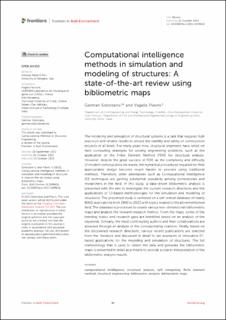| dc.contributor.author | Ramirez, German Solorzano | |
| dc.contributor.author | Plevris, Vagelis | |
| dc.date.accessioned | 2022-11-28T11:35:55Z | |
| dc.date.available | 2022-11-28T11:35:55Z | |
| dc.date.created | 2022-11-26T22:45:47Z | |
| dc.date.issued | 2022 | |
| dc.identifier.citation | Frontiers in Built Environment. 2022, 8 . | en_US |
| dc.identifier.issn | 2297-3362 | |
| dc.identifier.uri | https://hdl.handle.net/11250/3034449 | |
| dc.description.abstract | The modeling and simulation of structural systems is a task that requires high precision and reliable results to ensure the stability and safety of construction projects of all kinds. For many years now, structural engineers have relied on hard computing strategies for solving engineering problems, such as the application of the Finite Element Method (FEM) for structural analysis. However, despite the great success of FEM, as the complexity and difficulty of modern constructions increases, the numerical procedures required for their appropriated design become much harder to process using traditional methods. Therefore, other alternatives such as Computational Intelligence (CI) techniques are gaining substantial popularity among professionals and researchers in the field. In this study, a data-driven bibliometric analysis is presented with the aim to investigate the current research directions and the applications of CI-based methodologies for the simulation and modeling of structures. The presented study is centered on a self-mined database of nearly 8000 publications from 1990 to 2022 with topics related to the aforementioned field. The database is processed to create various two-dimensional bibliometric maps and analyze the relevant research metrics. From the maps, some of the trending topics and research gaps are identified based on an analysis of the keywords. Similarly, the most contributing authors and their collaborations are assessed through an analysis of the corresponding citations. Finally, based on the discovered research directions, various recent publications are selected from the literature and discussed in detail to set examples of innovative CIbased applications for the modeling and simulation of structures. The full methodology that is used to obtain the data and generate the bibliometric maps is presented in detail as a means to provide a clearer interpretation of the bibliometric analysis results. | en_US |
| dc.language.iso | eng | en_US |
| dc.publisher | Frontiers Media | en_US |
| dc.rights | Navngivelse 4.0 Internasjonal | * |
| dc.rights.uri | http://creativecommons.org/licenses/by/4.0/deed.no | * |
| dc.subject | Computational intelligence | en_US |
| dc.subject | Soft computing | en_US |
| dc.subject | Structural engineering | en_US |
| dc.subject | Bibliometric analysis | en_US |
| dc.title | Computational intelligence methods in simulation and modeling of structures: A state-of-the-art review using bibliometric maps | en_US |
| dc.title.alternative | Computational intelligence methods in simulation and modeling of structures: A state-of-the-art review using bibliometric maps | en_US |
| dc.type | Peer reviewed | en_US |
| dc.type | Journal article | en_US |
| dc.description.version | publishedVersion | en_US |
| cristin.ispublished | true | |
| cristin.fulltext | original | |
| cristin.qualitycode | 1 | |
| dc.identifier.doi | https://doi.org/10.3389/fbuil.2022.1049616 | |
| dc.identifier.cristin | 2081696 | |
| dc.source.journal | Frontiers in Built Environment | en_US |
| dc.source.volume | 8 | en_US |
| dc.source.pagenumber | 24 | en_US |

